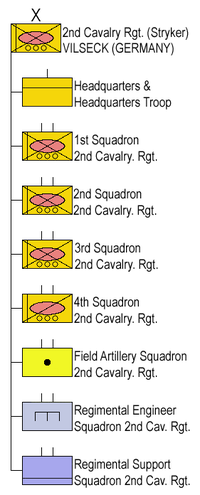2nd Cavalry Regiment (United States)
The 2nd Cavalry Regiment ( German 2nd US Cavalry Regiment ) is a Cavalry - Regiment of the US Army . The regiment is the longest uninterrupted formation in the US Army. The regiment has its headquarters in the Rose Barracks in Vilseck (Germany).
history
On May 23, 1836, the 2nd Dragoon Regiment was set up by US President Andrew Jackson . The regiment was renamed the 2nd US Cavalry in 1861, the 2nd Cavalry Group (mechanized) in 1941 , the 2nd Armored Cavalry Regiment in 1948 and the 2nd Stryker Cavalry Regiment in 2006 . When it was renamed the 2nd Cavalry Regiment in 2011 , the regiment was again based more on the designation from 1861.
During the Cold War , the regiment was responsible for securing the Iron Curtain in Bavaria in the border section to the GDR and the CSSR as part of the VII Corps of the 7th US Army . His headquarters were in the Merrell Barracks in Nuremberg .
On November 8, 1990, the VII Corps was ordered to move to the Persian Gulf to take part in Operations Desert Shield / Storm to liberate Iraq- occupied Kuwait . The 2ACR was the first unit of the corps to be completely stationed in the Iraqi-Saudi border area from mid-December. During the land war of February 24-28, 1991, the regiment, under the command of Colonel Leonard D. "Don" Holder, led the units of the VII Corps in battle against the divisions of the Republican Guards . Three companies (E, G, and I Troop) of the regiment encountered a tank brigade of the Iraqi Tawakalna Division on the afternoon of February 26th and destroyed them in the Battle of 73 Easting ("Battle of 73 Easting"). At the end of the ground war, the regiment had seven dead and 19 wounded soldiers to mourn.
Then the regiment was initially brought back to Germany, but soon moved to the United States and the equipment was switched from Bradley armored personnel carriers to HMMWV vehicles. Participation in peacekeeping operations in Haiti and Bosnia-Herzegovina followed .
In 2003 the regiment took part in the invasion of Iraq ( Operation Iraqi Freedom ) and remained stationed there until the end of 2004. After returning to the United States, the regiment was reformed into a Stryker Brigade Combat Team . In 2006 the regiment returned to Germany after a fundamental change in its structures and was placed under the 5th US Corps . Since then, the location has been the Rose Barracks in Vilseck . In the summer of 2007 the regiment was relocated to Iraq for another 15 month mission. In 2010/2011 the entire unit was in Afghanistan for 12 months.
organization
The 2nd Cavalry Regiment is a Stryker Brigade Combat Team (SBCT) that can be deployed as an air deployable, independently operating emergency force within 96 hours worldwide. The backbone of the regiment is the Stryker armored vehicle , on which all of its combat and support vehicles are based.
In contrast to the usual in the US Army form the designation of units train ( Platoon ), Company (Company) Battalion (Battalion) and regiment are the designations in the US cavalry regiments Platoon, Troop, Squadron ( squadron ) and Regiment .
The following units are part of the brigade:
- 2nd Cavalry Regiment Stryker Brigade Combat Team:
- Headquarters company
- 1st Squadron , 2nd Cavalry Regiment - (Stryker)
- 2nd Squadron, 2nd Cavalry Regiment - (Stryker)
- 3rd Squadron, 2nd Cavalry Regiment - (Stryker)
- 4th Squadron, 2nd Cavalry Regiment - (Reconnaissance and target acquisition squadron)
- Field Artillery Squadron , 2nd Cavalry Regiment - with three 6 × 155 mm howitzer batteries
- Regimental Engineer Squadron , 2nd Cavalry Regiment
- Regimental Support Squadron, 2nd Cavalry Regiment - Medicine, Support and Logistics Squads
Known relatives
- Douglas Macgregor Colonel, political scientist, military theorist, author, advisor and White House candidate for the office of United States Ambassador to Germany
References
literature
- Tom Clancy , Armored Cavalry: The Linked American Armored Units. Munich 1997 (good overview of the history of the regiment up to 1992).
- Hans-Jürgen Schmidt: At the limit of freedom. The US and BGS associations at the Iron Curtain 1945–1990. Border History Verlag, Bad Bocklet.
- William M. Tevington: National Historian US Constabulary Association. Turner Publishing Company, Paducah, Kentucky.
- John Capone: Forgotten Peacekeepers. Mobility, Vigilance, Justice. Published by Stand up America. Bigfork, Montana.
Web links
Individual evidence
- ↑ Stars and Stripes, December 2, 2011 (accessed January 28, 2013)
- ↑ See Tom Clancy: Armored Cavalry. The associated American armored units. Munich 1997
- ↑ Global Security. on Globalsecurity.org
- ↑ See Tom Clancy: Armored Cavalry. The associated American armored units. Munich 1997, p. 268.



